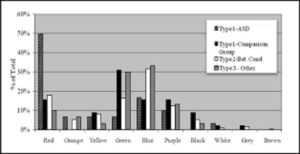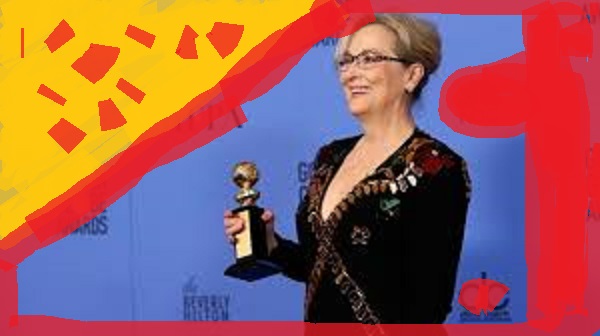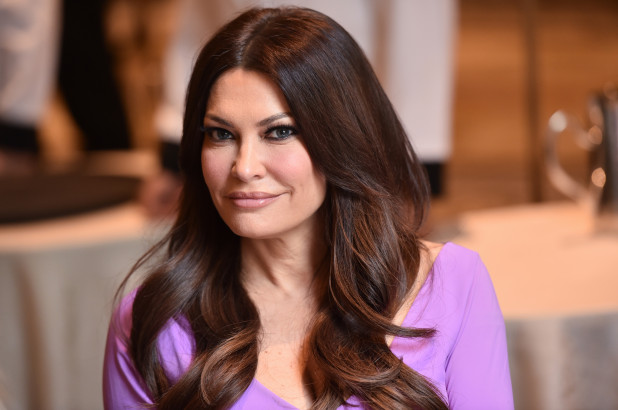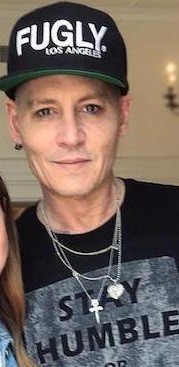Meryl Streep and Other Actors Suffering From a Form of Autism
 According to a somewhat shocking revelation from the worlds of both Psychiatric Medicine(1) and Developmental Biology, the average American with basic social skills and academic acumen — which need not include college or post graduate education — will hear or read the words spoken by Meryl Streep at the 2017 Golden Globe Awards and come away with two different opinions according to the recent discovery of a new frame of autism(2) that seems to afflict many or most people who are drawn, since childhood, to careers in acting or performing.
According to a somewhat shocking revelation from the worlds of both Psychiatric Medicine(1) and Developmental Biology, the average American with basic social skills and academic acumen — which need not include college or post graduate education — will hear or read the words spoken by Meryl Streep at the 2017 Golden Globe Awards and come away with two different opinions according to the recent discovery of a new frame of autism(2) that seems to afflict many or most people who are drawn, since childhood, to careers in acting or performing. 
“Content and essentially functional individuals – those without any evidence of a new autism criteria – will be confused by Meryl Streep’s words at The Golden Globe Awards for 2017. words, The rest — excluding those who do not understand the political process owing to any organic brain disorders or significant intellectual limitations — will sit somewhere on the new “spectrum” of autism and they will celebrate her words and view them as highly important and inspiring.” [Raymond Totondi, MD PhD. Skylight Institue, Bern Switzerland.]
HOLLYWOOD THINKING AS A SIGN OF AUTISM
“Actors choose acting as a career to compensate for their inability to communicate or empathize on normal human levels. (3) It’s not a far-fetched concept in the sense that it can be easily demonstrated in a small control group of working actors, employed or unemployed, and ordinary working people in the same situations. “ [Helen LaVista, MD PhD University of Nevada.]
Without getting into highly complicated medical jargon, According to Dr. LaVista, the “normal” people — those who show none of the signs of autism as it is known — will question why Meryl Streep and others like her would muddy the stage of an awards show with a political diatribe that has nothing to do with their work as actors. They will question the reasoning and the validity and the pertinence of these politically volatile outbursts. (4) The others – those who test within the new spectrum of autism — will view Meryl Streep’s words as inspiring and important. They will not be able to understand that working on a stage and working on a loading dock does not give one any better or higher platform from which to spout political opinions. “They just don’t get it,” said Dr. LaVista.
““Prior to 2013, autism was graded on a 3 level scale. (5) Depending on the degree of personality deficit, those afflicted with autism would be marked as: 1) ASPERGER SYNDROME, 2) AUTISTIC DISORDER, 3) PDD-NOS or Pervasive Developmental Disorder, Not Otherwise Specified. Now things are very different.”
Dr, LaVista explained that these three levels of Diagnostic Autism – the proverbial “spectrum” – ceased to exist as such when doctors changed the whole thing around in 2013 by creating the new autistic element called (6) SCD – SOCIAL COMMUNICATIVE DISORDER – a milder version(7) of autism which usually goes unnoticed, but has been used to explain the strange behavior of people who choose acting or the performing arts as a means to earn a living.
“Actors with conservative leanings account for just 11% of those who report as “working actors,” which fall well within both the margin of error and the concept that somewhere within that margin of error we find people with other types of personality issues which manifest as a need to act or perform.”
The new autism spectrum is much more all-encompassing. Some people afflicted seem to be intelligent and articulate, while others suffer from profoundly deficient issues(8) with empathy, reality and acceptance. The one thing that all or most of these afflicted have in common is that they often work as actors.
“This study explains the liberal behavior of many actors in Hollywood and the difficult behavior of stage performers that has been spoken about for centuries,” said Dr. Katman F. Gleason, a psychiatrist specializing in Abnormal Brain Development and Developmental Social Skills.
“These people prefer to be among others like themselves although they are not consciously aware of this tendency. They assume that they are surrounded by good people who think like they do, when in fact, they truly have no real empathy or attachment to anyone but themselves. (9)Friendships, relationships and marriages in this group are very superficial and transient in nature. Even simple things like a hug or a kiss on the cheek is part of the “performance” they put on from one minute to the next. There is no (10) sincerity in spite of the fact that these people see themselves as highly virtuous and compassionate.
 “It explains why an actress like Meryl Streep will, at one moment, stand to enthusiastically applaud the work of motion picture director Roman Polanski – ignoring the fact that he is a child rapist who fled the United States in the 1970s to escape going to prison, and at the next moment, she will pretend to shed tears over a physically challenged man she believes was mocked by US President-elect Donald Trump. “
“It explains why an actress like Meryl Streep will, at one moment, stand to enthusiastically applaud the work of motion picture director Roman Polanski – ignoring the fact that he is a child rapist who fled the United States in the 1970s to escape going to prison, and at the next moment, she will pretend to shed tears over a physically challenged man she believes was mocked by US President-elect Donald Trump. “
So what does all this mean? It seems to mean that many or most of Hollywood actors thrive together in some kind of biosphere where they compliment each other until they lose whatever contact they may have had with reality. They seem to detest people outside of their world even if those people share their political beliefs.
“The reason they loathe their own fans, even those with whom they seem to agree – referring to them as people who watch football or mixed martial arts — is because they are not even aware of what their political opinions really mean. For them it’s the same as acting and rehearsing dialogue. Sadly, actors are always acting and acting out. It’s actually a tragic situation.” [Dr, Helen LaVista MD PhD].
- Landa RJ (2008). “Diagnosis of autism spectrum disorders in the first 3 years of life”. Nat Clin Pract Neurol. 4 (3): 138–47. doi:10.1038/ncpneuro0731
 . PMID 18253102.
. PMID 18253102. - ^ Jump up to:a b Stefanatos GA (2008). “Regression in autistic spectrum disorders”. Neuropsychol Rev. 18 (4): 305–19. doi:10.1007/s11065-008-9073-y. PMID 18956241.
- ^ Jump up to:a b c Autism Spectrum Disorder, 299.00 (F84.0). In: American Psychiatric Association. Diagnostic and Statistical Manual of Mental Disorders, Fifth Edition. American Psychiatric Publishing; 2013.
- Jump up^ Chaste P, Leboyer M (2012). “Autism risk factors: genes, environment, and gene-environment interactions”. Dialogues in Clinical Neuroscience. 14: 281–92. PMC 3513682
 . PMID 23226953.
. PMID 23226953. - Jump up^ Ornoy A, Weinstein-Fudim L, Ergaz Z (2015), “Prenatal factors associated with autism spectrum disorder (ASD)”, Reproductive Toxicology, 56: 155–169, doi:10.1016/j.reprotox.2015.05.007, PMID 26021712
- ^ Jump up to:a b Rutter M (2005). “Incidence of autism spectrum disorders: changes over time and their meaning”. Acta Paediatr. 94 (1): 2–15. doi:10.1111/j.1651-2227.2005.tb01779.x. PMID 15858952.
- ^ Jump up to:a b c d e f g h Levy SE, Mandell DS, Schultz RT (2009). “Autism”. Lancet. 374 (9701): 1627–38. doi:10.1016/S0140-6736(09)61376-3. PMC 2863325
 . PMID 19819542.
. PMID 19819542. - ^ Jump up to:a b c d Johnson CP, Myers SM (2007). “Identification and evaluation of children with autism spectrum disorders”. Pediatrics. 120 (5): 1183–215. doi:10.1542/peds.2007-2361
 . PMID 17967920. Archived from the original on 8 February 2009.
. PMID 17967920. Archived from the original on 8 February 2009. - ^ Jump up to:a b c d e f g Myers SM, Johnson CP (2007). “Management of children with autism spectrum disorders”. Pediatrics. 120 (5): 1162–82. doi:10.1542/peds.2007-2362
 . PMID 17967921.
. PMID 17967921. - ^ Jump up to:a b c Helt M, Kelley E, Kinsbourne M, Pandey J, Boorstein H, Herbert M, Fein D (2008). “Can children with autism recover? if so, how?”. Neuropsychol Rev. 18 (4): 339–66. doi:10.1007/s11065-008-9075-9. PMID 19009353.
- Jump up^ Howlin P, Goode S, Hutton J, Rutter M (2004). “Adult outcome for children with autism”. J Child Psychol Psychiatry. 45 (2): 212–29. doi:10.1111/j.1469-7610.2004.00215.x. PMID 14982237.
- ^ Jump up to:a b Silverman C (2008). “Fieldwork on another planet: social science perspectives on the autism spectrum”. Biosocieties. 3 (3): 325–41. doi:10.1017/S1745855208006236.
- ^ Jump up to:a b Global Burden of Disease Study 2013 Collaborators (2015). “Global, regional, and national incidence, prevalence, and years lived with disability for 301 acute and chronic diseases and injuries in 188 countries, 1990–2013: a systematic analysis for the Global Burden of Disease Study 2013.”. Lancet. 386: 743–800. doi:10.1016/S0140-6736(15)60692-4. PMC 4561509
 . PMID 26063472.
. PMID 26063472. - Jump up^ “ASD Data and Statistics”. CDC.gov. Archived from the original on 18 April 2014. Retrieved 5 April 2014.
- ^ Jump up to:a b “Prevalence of autism spectrum disorders — autism and developmental disabilities monitoring network, 14 sites, United States, 2008”. MMWR Surveill Summ. 61 (3): 1–19. 2012. PMID 22456193. Archived from the original on 25 March 2014.
- ^ Jump up to:a b Blumberg SJ, Bramlett MD, Kogan MD, Schieve LA, Jones JR, Lu MC (2013). “Changes in prevalence of parent-reported autism spectrum disorder in school-aged U.S. children: 2007 to 2011–2012” (PDF). Natl Health Stat Report (65): 1–11. PMID 24988818. Archived (PDF) from the original on 21 September 2013.
- ^ Jump up to:a b Brugha T, Cooper SA, McManus S, et al. (31 January 2012). “Estimating the prevalence of autism spectrum conditions in adults: extending the 2007 Adult Psychiatric Morbidity Survey” (PDF). The Information Centre for Health and Social Care. National Health Service, UK. Retrieved 29 December 2014.
- ^ Jump up to:a b c d Newschaffer CJ, Croen LA, Daniels J, Giarelli E, Grether JK, Levy SE, Mandell DS, Miller LA, Pinto-Martin J, Reaven J, Reynolds AM, Rice CE, Schendel D, Windham GC (2007). “The epidemiology of autism spectrum disorders” (PDF). Annu Rev Public Health. 28: 235–58. doi:10.1146/annurev.publhealth.28.021406.144007. PMID 17367287. Archived from the original (PDF) on 3 September 2013.
- ^ Jump up to:a b Geschwind DH (2008). “Autism: many genes, common pathways?”. Cell. 135 (3):
“




Pretty solid analysis.
Yes, share this story, Ras Baba — it needs to be told.
Streep is overrated and overpaid. She doesn’t get to dictate to people what to do about the new President. Her ego is bigger than her gaping hole.
Wow now i understand whats wrong with Shia Lebeuf and Leonardo di Caprio
bingo, neeters!
damien legallienne
editor
Lmfao
Of course, using the criteria laid out in this non-professional medical analysis, this same “diagnosis” would apply to Clint Eastwood, Chuck Norris, Arnold Schwartzenegger, and all the icons of the right as well, wouldn’t it? Of course it would. It applies to EACH AND EVERY PERSON IN THE PERFORMING ARTS, as laid out here.
Proof positive that non-professionals shouldn’t attempt to interpret medical information they glean from the internet.
IRRATIONAL and POOR READING COMPREHENSION on your part, Rational. You named 4 people out of THOUSANDS while the study proves that 11% suffer from variants of this disorder or other forms of self-involved spectral disorders. Knowing that would have implied that you’d actually read the fucking story — but you didn’t — because you’re a stupid, pussy hate fucking douche bag.
I’m sorry you don’t understand the concept of examples. I didn’t realize I’d have to list every actor who ever existed in order for you to comprehend.
My point, which you conveniently ignored in your tantrum of an answer, is generalizations and amatuer medical diagnoses are dangerous.
It’s not AMATEUR simply because you say it is. It was a peer reviewed study. Geez!
Trying one more time. No peer reviewed study would lump EVERYONE in a particular profession into one mental health classification. The professionals who would need a new profession, because they don’t know what they’re doing.
As there is no author cited, I made the assumption that you wrote it. Apparently, you just stole someone else’s work in violation of copyright laws and posted it on your blog. My mistake.
I do find it fascinating, however, that not one of the cited sources mentions the word actor or acting. I find that rather curious, to say the least.
Any plan on your part to ever address my point of gross generalizations, which I emphasize, a real professional would never do.
Dear Rational — The purpose of my blog is to expose stupidity and dumbness. Rarely do I actually write stories that are obviously stupid or dumb. Instead, I rely on the comments from people like yourself to prove out the fact that the average person is stupid and dumb, and thereby proving my mission statement. You, Rational, are on stage — right now — this week in front of about 30,784 readers — and YOU are the star of my show. Your comments, and your continuing debate with me with your comments — each response escalating to another level of anger and stupidity — are why I make money writing this shit, and why, in the past 7 years, I have attracted 6 million readers. Most of them do not read the articles. They read the comments because, like I said, it’s all about stupidity and dumbness and you’re about the dumbest I’ve ever had. Sadly, you are not “funny dumb.” You’re just DUMB DUMB — which is actually kind of funny. Damien LeGallienne EDITOR – PS — I NEVER STEAL ANYONE’S WORK. EVER!!!!
I thought Rational’s comments were just that. Rational. I was gonna count how many times you called him “dumb” in your response but ehhhhh.. ?
So basically anyone who disagrees with you is “dumb” correct? I find that very mature. My 7 year old does too lol
Okay, then — Rational is rational. You are the dumb one. Feel better?
Yes. Anyone who disagrees with me is dumb. There are no exceptions.
Most of us Autistics don’t “suffer from autism” yes, we have some traits that can make life difficult, especially when it comes to interacting with people who aren’t like us. But for the most part the nuerotype just means we think differently and have different sensory needs. I mean one could describe my sensitivity to sound as “suffering” (and yes, high pitch noises and chaos give me headaches) but it’s also why I’m such a good musician.